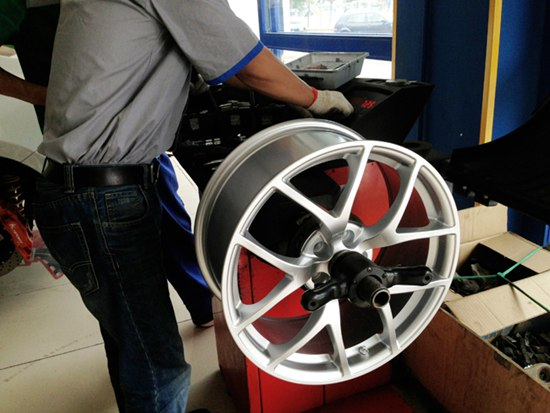Mag wheels are, as the name implies, a type of car wheel made of a magnesium metal alloy. Their light weight makes them popular in racing applications and their aesthetic qualities make them ideal aftermarket equipment for automotive enthusiasts. They can usually be identified by their symmetrical spokes and high gloss finish.
A typical set of mag wheels can weigh significantly less than aluminum or steel wheels. Strong, lightweight wheels are especially important in racing due to the benefits of lower unsprung weight. Unsprung weight is a measure of the car’s wheels, suspension, brakes and related components – basically everything that is not supported by the suspension itself. A low unsprung weight provides better acceleration, braking, handling and other driving characteristics. In addition, a lighter wheel typically has better traction than a heavier wheel because it responds more quickly to bumps and ruts in the driving surface.
These wheels are built using a one-step forging process, most commonly with the alloy known as AZ91. The “A” and “Z” in this code stand for aluminum and zinc, which are the primary metals in the alloy, aside from magnesium. Other metals commonly used in magnesium alloys include silicon, copper, and zirconium.
Mag wheels first rose to prominence during the American muscle car era of the 1960s. As enthusiasts strived for greater and more unique ways of making their vehicles stand out, aftermarket wheels became an obvious choice. Mags, with their high shine and racing heritage, were prized for their looks and performance. Due to their popularity, they prompted a large number of imitations and forgeries. Steel wheels coated in chrome could replicate the look, but not the strength and light weight of magnesium alloys.
For all their benefits, the main downside of mag wheels is their cost. A quality set can cost as much as double the price of a more conventional set. As a result, they are not commonly used for daily driving, and are not always offered as stock equipment on cars, though that can change among higher-end models. In professional racing, of course, cost is less of an issue compared to performance.
In addition, magnesium has a reputation as a highly flammable metal. With an ignition temperature of 1107°F (597°C), and a melting point of 1202°F (650°Celsius), however, magnesium alloy wheels are unlikely to pose any additional danger, in either normal driving or racing use. Magnesium fires have been known to occur with these products, however, and are usually difficult to extinguish.
Post time: Jul-24-2021

